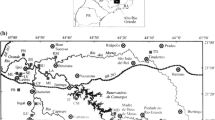Abstract
Objective quantitative indicators for the fragmentation of suburban woodlands based on high-resolution remote sensing, ground verification, and methods of GIS analysis have been developed. The density of trails in the territory and the extent of their influence depending on the intensity of use are estimated. The methodical approaches are tested by the example of the large woodland in Akademgorodok of the city of Novosibirsk.
Similar content being viewed by others
References
Basile, J.V., and Lonner, T.N., Vehicle restrictions influence elk and hunter distribution in Montana, J. For., 1979, vol. 77, no. 3, pp. 155–159.
Ermakov, N.B., Korolyuk, A.Yu., and Lashchinskiy, N.N., Floristicheskaya klassifikatsiya mezofil’nykh travyanykh lesov Yuzhnoi Sibiri (Floristic Classification of Mesophylic Herbaceous Forests in Southern Siberia), Novosibirsk: Tsentr. Sib. Bot. Sad, Sib. Otd., Akad. Nauk SSSR, 1991.
Forman, T.T. and Sperling, D., Road Ecology. Science and Solutions, Washington, DC: Island Press, 2003.
Franklin, A.B., Noon, B.R. and George, T.L., What is habitat fragmentation? Stud. Avian Biol., 2002, no. 25, pp. 20–29.
Gibb, H and Hochuli, D.F., Habitat fragmentation in an urban environment: large and small fragments support different arthropod assemblages, Biol. Conserv., 2002, vol. 106, pp. 91–100.
Guide for analysis of the environmental impact of planning, building, reconstruction, and operation of the road objects, 2001. http://www.complexdoc.ru.
Harper, S.J., Bollinger, K. and Barret, G.W., Effects of habitat patch shape on population dynamics of meadow voles (Microtus pennsylvanicus), J. Mamm., 1993, vol. 72, pp. 1045–1055.
Lashchinskiy, N.N., Vegetation cover in Akademgorodok district, in Priroda Akademgorodka: 50 let spustya (Nature of Akademgorodok District: 50 Years Later), Novosibirsk: Sib. Otd., Ross. Akad. Nauk, 2007, pp. 41–46.
Lashchinskiy, N.N., Zolnikov, I.D., Andreenkov, O.V., Glushkova, N.V., Lashchinskaya, N.V., and Andreenkova, N.G., Analysis of forest path network of the upper zone of Akademgorodok district, in Dinamika ekosistem Novosibirkogogo Akademgorodka (Dynamics of Ecosystems of Akademgorodok District in Novosibirsk), Novosibirsk: Sib. Otd., Ross. Akad. Nauk, 2013, pp. 75–84.
Lyon, L.J., Habitat effectiveness for elk as influenced by roads and cover, J. For., 1979, vol. 77, no. 10, pp. 658–660.
Nally, R.M., Bennett, A.F. and Horrocks, G., Forecasting the impact of habitat fragmentation. Evaluation of the impact of habitat fragmentation on birds in box iron bark forests of central Victoria, Australia, Biol. Conserv., 2000, vol. 95, pp. 7–29.
Parker, M. and Mac Nally, R., Habitat loss and the fragmentation threshold: an experimental evaluation of impacts on richness and total abundances using grassland invertebrates, Biol. Conserv., 2002, vol. 102, pp. 217–229.
Rost, G.R. and Bailey, J.A., Distribution of mule deer and elk in relation to roads, J. Wildl. Manage., 1979, vol. 43, pp. 634–641.
Saunders, D.A., Hobbs, R.J., and Margules, C.R., Biological consequences of ecosystem fragmentation: a review, Conserv. Biol., 1991, vol. 5, pp. 18–32.
Schmielgelow, F.K.A. and Mönkkönen, M., Habitat loss and fragmentation in dynamic landscapes: avian perspectives from the boreal forest, Ecol. Appl., 2002, vol. 12, no. 2, pp. 375–389.
Sorokina, G.A., Shikalova, E.A., and Pakhar’kova, N.V., Stress effect of the road-path network on the plant communities, Khvoinye Boreal’noi Zony, 2010, vol. 27, nos. 3–4, pp. 243–246.
Tscharntke, T., Fragmentation of Phragmites habitat, minimum viable population size,habitat suitability,and local extinction of moths, midges,flies,aphids and birds, Conserv. Biol., 1992, vol. 6, no. 4, pp. 530–536.
Wilcox, B.A and Murphy, D.D., Conservation strategy: the effects of fragmentation on extinction, Am. Nat., 1985, vol. 125, pp. 879–887.
Zol’nikov, I.D., Airiyants, A.A., Korolyuk, A.Yu., and Martysevich, U.V., Approach to modeling of a regional ecological system and spatial relations of its components based on integrated interdisciplinary information, Contemp. Probl. Ecol., 2008, vol. 1, no. 1, pp. 29–37.
Zolnikov, I.D., Lyamina, V.A., and Korolyuk, A.Yu., Complex technology of mapping and monitoring of heterogenic vegetation cover, Geogr. Prirod. Resur., 2010, no. 2, pp. 126–131.
Author information
Authors and Affiliations
Corresponding author
Additional information
Original Russian Text © N.N. Lashchinskiy, I.D. Zolnikov, N.V. Glushkova, N.V. Lashchinskaya, 2016, published in Sibirskii Ekologicheskii Zhurnal, 2016, No. 5, pp. 774–781.
Rights and permissions
About this article
Cite this article
Lashchinskiy, N.N., Zolnikov, I.D., Glushkova, N.V. et al. A new method for evaluating the degree of anthropogenic transformation of suburban woodlands. Contemp. Probl. Ecol. 9, 636–642 (2016). https://doi.org/10.1134/S1995425516050097
Received:
Accepted:
Published:
Issue Date:
DOI: https://doi.org/10.1134/S1995425516050097




